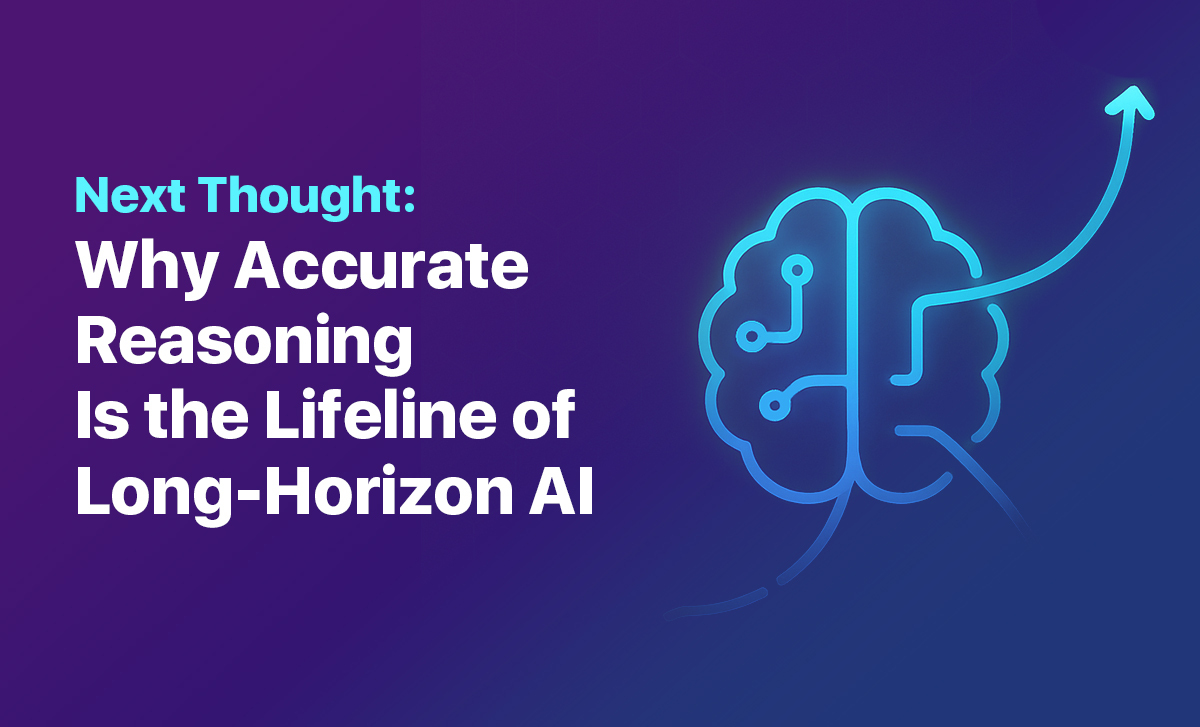
Get in Touch
Tell us about yourself and we will get back to you as soon as we can.

Tell us about yourself and we will get back to you as soon as we can.


“The moment an agent’s next thought strays, every future step inherits the error.”
AI systems wow us with short one-shot answers, but give them a mission that stretches across hours, days, or thousands of API calls and a different reality appears: small reasoning slips snowball into mission-ending failures. In long-horizon tasks, the next thought, the immediate reasoning step that bridges the current state to the next action, decides whether the agent climbs toward success or tumbles into compounding error.
When a chef plans a seven-course dinner, they don’t imagine every micro-move at once. Instead they:
This rolling horizon keeps human plans resilient. If the oven malfunctions, the chef instantly revises the next thought: “Switch to the convection setting.”
Humans are remarkably good at recovering from errors. When a plan fails, we rarely give up, we debug, re-plan, and try again. Sometimes, our “next thought” is intuition. Sometimes, it’s explicit problem-solving.
For AI, explicit reasoning can be coded, but intuition must be learned from vast experience. The goal is to design agents that can flexibly switch between both, leveraging structured reasoning when possible and falling back on learned intuition when facing the unknown.
Large language models (LLMs)) produce tokens, but agents built on top of them need coherent thoughts and structured representations of a sub-goal plus rationale:
Example :
THOUGHT 17:
Goal: Parse the 'transactions.csv' file and identify outliers.
Reasoning: Use pandas to calculate z-scores; flag rows where |z| > 3.
Action: Write Python code snippet.Each thought sets the initial conditions for Thought 18. If Thought 17 misunderstands column names, the entire analysis corrupts.
Long-horizon tasks are those that require an AI agent to reason, plan, and act over an extended series of steps, sometimes thousands or even millions. In these settings, every next thought determines the success or failure of the entire mission.
In each case, even a single bad thought early on can derail the outcome.
No matter how powerful an AI model is, its next thought is only as good as the information it’s working with. Context engineering the process of carefully selecting, formatting, and feeding the right information into the model directly determines the quality and accuracy of each reasoning step.
If the model receives irrelevant, outdated, or noisy data, its next thought will be misguided, even if the model itself is state-of-the-art. Clean, relevant context acts as the foundation for good reasoning.
For long-horizon tasks, the agent needs to keep track of what’s already happened, what’s true right now, and what constraints or objectives are in play. Good context engineering ensures the model isn’t hallucinating or acting on stale assumptions.
When the context for each step is accurate and up-to-date, mistakes are less likely to compound across reasoning steps. The agent can “course-correct” because it always knows where it stands.
Many tasks require integrating multiple sources, tool outputs, previous actions, live data feeds, user instructions. Effective context engineering ensures the model pulls the right information at the right moment for planning the next task for action in order to achieve the end goal.
The longer and more complex the task, the more vital it is for each next thought to be based on the true current state. Without curated, engineered context, agents quickly drift off course and fail to achieve their goals.
In short, Context engineering is the bridge between raw data and effective reasoning. It ensures every “next thought” is rooted in reality, aligned with the task, and maximally likely to move the agent toward success.
The ability to generate the right next thought again and again, over hours or thousands of steps is what separates fleeting AI demos from robust, mission-capable agents. Long-horizon success isn’t about superhuman intelligence or brute force; it’s about disciplined, accurate reasoning at every juncture, powered by the right context at the right time.
As we push AI toward ever more ambitious, autonomous tasks, we can’t shortcut the fundamentals: every future action inherits the quality of the agent’s last reasoning step. That’s why the next thought and the context that informs it isn’t just a technical detail. It’s the lifeline of truly reliable, goal-driven AI.